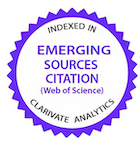Silagens mistas de cana-de-açúcar e amendoim forrageiro tratadas com Lactobacillus buchneri
DOI:
https://doi.org/10.1590/1809-6891v23e-72352EResumo
O objetivo do estudo foi avaliar composição química, perfil fermentativo, população de microrganismos e recuperação de matéria seca (RMS) de silagem de cana-de-açúcar contendo níveis crescentes (0, 25, 50 e 75%, na base da matéria natural) de amendoim forrageiro (Arachis pintoi cv. Belmonte), tratadas ou não com Lactobacillus buchneri. Usou-se o esquema fatorial 4×2, no delineamento inteiramente casualizado, com três repetições. Verificou-se efeito de interação níveis de amendoim forrageiro e inoculante para teores de matéria seca, proteína bruta, fibra em detergente neutro e ácido, ácidos orgânicos e etanol, população de bactérias láticas e leveduras, perdas por gases e por efluente e RMS. Houve efeito de níveis de amendoim forrageiro no teor de hemicelulose, nitrogênio insolúvel em detergente ácido, pH e nitrogênio amoniacal. Verificou-se que o aumento de níveis de amendoim forrageiro incrementou teor de proteína e diminuiu teor de fibra, além de reduzir a produção de etanol e de efluente. Recomenda-se inclusão de 40% a 75% de amendoim forrageiro na ensilagem de cana-de-açúcar para melhorar a composição química e o perfil de fermentação. A inoculação com L. buchneri associada ao amendoim forrageiro aumenta a concentração de ácidos antifúngicos na silagem e decresce a população de leveduras e a produção de etanol.
Palavras-chave: Ácidos orgânicos; Composição química; Etanol; Microrganismos; Recuperação de matéria seca
Downloads
Referências
Gomes ALM, Bueno AVI, Osmari MP, Machado J, Nussio LG, Jobim CC, et al. Effects of Obligate Heterofermentative Lactic Acid Bacteria Alone or in Combination on the Conservation of Sugarcane Silage. Front Microbiol [Internet]. 2021;12. Available from: https://www.frontiersin.org/article/10.3389/fmicb.2021.643879
Ávila CLS, Carvalho BF, Pinto JC, Duarte WF, Schwan RF. The use of Lactobacillus species as starter cultures for enhancing the quality of sugar cane silage. J Dairy Sci [Internet]. 2014;97(2):940–51. Available from: https://www.sciencedirect.com/science/article/pii/S0022030213008485
Oude Elferink S, Krooneman J, Gottschal J, Spoelstra SF, Faber F, Driehuis F. Anaerobic Conversion of Lactic Acid to Acetic Acid and 1,2-Propanediol by Lactobacillus buchneri. Appl Environ Microbiol. 2001 Feb 1;67:125–32.
Muck RE, Nadeau EMG, McAllister TA, Contreras-Govea FE, Santos MC, Kung L. Silage review: Recent advances and future uses of silage additives. J Dairy Sci [Internet]. 2018;101(5):3980–4000. Available from: https://www.sciencedirect.com/science/article/pii/S0022030218303229
da Silva JS, Ribeiro KG, Pereira OG, Mantovani HC, Cecon PR, Pereira RC, et al. Nutritive value and fermentation quality of palisadegrass and stylo mixed silages. Anim Sci J. 2018 Jan;89(1):72–8.
Paganella M, Valls J. Caracterização morfológica de cultivares e acessos selecionados de Arachis pintoi. Pasturas Trop. 2002;24:22–9.
Gomes FM, Ribeiro KG, De Souza IA, De Lima Silva J, Agarussi MCN, Da Silva VP, et al. Chemical composition, fermentation profile, microbial population and dry matter recovery of silages from mixtures of palisade grass and forage peanut. Trop Grasslands-Forrajes Trop. 2021;9(1):34–42.
Santos HG, Jacomine PKT, Anjos LHC, Oliveira VA, Lumbreras JF, Coelho MR, et al. Sistema Brasileiro de Classificação de Solos. Brasília: Embrapa; 2018.
Jobim C, Nussio L, Reis R, Schmidt P. Avanços metodológicos na avaliação da qualidade da forragem conservada. Rev Bras Zootec J Anim Sci - REV BRAS ZOOTECN. 2007 Jul 1;36.
Kung Jr L. Preparation of silage water extracts for chemical analysis: Standard operating procedure-001 6.03.96. Delaware; 1996.
Filya I, Muck RE, Contreras-Govea FE. Inoculant Effects on Alfalfa Silage: Fermentation Products and Nutritive Value. J Dairy Sci [Internet]. 2007;90(11):5108–14. Available from: https://www.sciencedirect.com/science/article/pii/S002203020771980X
Siegfried V, Ruckermann H, Stumpf G, Siegfried B, Ruckemann H, Siegfried R, et al. Method for the determination of organic acids in silage by high performance liquid chromatography. Landwirtsch Forsch. [Internet]. 1984;37(3-4):298-304. Available from: https://www.scienceopen.com/document?vid=12545918-f45c-4b26-ad06-72577b416f09
AOAC. Official methods of analysis of AOAC International. Gaithersburg, Maryland: AOAC International; 2005.
Van Soest PJ, Robertson JB, Lewis BA. Methods for Dietary Fiber, Neutral Detergent Fiber, and Nonstarch Polysaccharides in Relation to Animal Nutrition. J Dairy Sci [Internet]. 1991 Oct 1;74(10):3583–97. Available from: https://doi.org/10.3168/jds.S0022-0302(91)78551-2
Licitra G, Hernandez TM, Van Soest PJ. Standardization of procedures for nitrogen fractionation of ruminant feeds. Anim Feed Sci Technol [Internet]. 1996;57(4):347–58. Available from: https://www.sciencedirect.com/science/article/pii/0377840195008373
Silva DJ, Queiroz AC. Análise de alimentos: métodos químicos e biológicos. 3th ed. Viçosa: UFV; 2002. 235 p.
Bolsen KK, Lin C, Brent BE, Feyerherm AM, Urban JE, Aimutis WR. Effect of Silage Additives on the Microbial Succession and Fermentation Process of Alfalfa and Corn Silages. J Dairy Sci. 1992;75(11):3066–83.
Gomes F, Ribeiro K, de Souza IA, Silva J, Agarussi M, Silva V, et al. Chemical composition, fermentation profile, microbial population and dry matter recovery of silages from mixtures of palisade grass and forage peanut. Trop Grasslands-Forrajes Trop. 2021 Jan 30;9:34–42.
Daniel J, Jacovaci F, Junges D, Santos M, Lima J, Anjos I, et al. Fibre digestibility and its relationships with chemical and morphological traits in thirty-two sugarcane varieties. Grass Forage Sci. 2016;72.
Cardoso LL, Ribeiro KG, Marcondes MI, Pereira OG, Weiß K. Chemical composition and production of ethanol and other volatile organic compounds in sugarcane silage treated with chemical and microbial additives. Anim Prod Sci [Internet]. 2019;59(4):721–8. Available from: https://doi.org/10.1071/AN16204
Jesus DLS, Rigueira JPS, Monção FP, Alves WS, Moura MMA, Sales ECJ, et al. Nutritive value of sugarcane silages added with increasing levels of acetic acid. Semin Agrar. 2019;40(5):2387–96.
Pereira DS, Lana R de P, Carmo DL do, Costa YKS da. Chemical composition and fermentative losses of mixed sugarcane and pigeon pea silage. Acta Sci Anim Sci [Internet]. 2019;41(1):e43709. Available from: https://periodicos.uem.br/ojs/index.php/ActaSciAnimSci/article/view/43709
Pirhofer-Walzl K, Søegaard K, Jensen HH, Eriksen J, Sanderson MA, Rasmussen J, et al. Forage herbs improve mineral composition of grassland herbage. Grass Forage Sci. 2011;66(3):415–23.
Driehuis F, Elferink SJ, Spoelstra SF. Anaerobic lactic acid degradation during ensilage of whole crop maize inoculated with lactobacillus buchneri inhibits yeast growth and improves aerobic stability. J Appl Microbiol. 1999 Oct;87(4):583–94.
Kung Jr L, Stokes MR, Lin CJ. Silage Additives, In Silage Science and Technology. Am Soc Agron. 2003 Jan 1;305–60.
Kung Jr L, Shaver RD, Grant RJ, Schmidt RJ. Silage review : Interpretation of chemical , microbial , and organoleptic components of silages 1. J Dairy Sci [Internet]. 2018;101(5):4020–33. Available from: http://dx.doi.org/10.3168/jds.2017-13909
Borreani G, Tabacco E, Schmidt RJ, Holmes BJ, Muck RE. Silage review: Factors affecting dry matter and quality losses in silages. J Dairy Sci [Internet]. 2018;101(5):3952–79. Available from: https://www.sciencedirect.com/science/article/pii/S0022030218303205
McDonald P, Henderson N, Heron S. The biochemistry of silage [Internet]. Marlow, England: Chalcombe; 1991. p. 340. Available from: http://books.google.com/books?id=oUcjAQAAMAAJ
Danner H, Holzer M, Mayrhuber E, Braun R. Acetic acid increases stability of silage under aerobic conditions. Appl Environ Microbiol [Internet]. 2003 Jan;69(1):562–7. Available from: https://pubmed.ncbi.nlm.nih.gov/12514042
Pahlow G, Muck R, Driehuis F, Oude Elferink S, Spoelstra SF. Microbiology of Ensiling. In: Silage Science and Technology. 2003. p. 31-93.
Axelsson L. Lactic acid bacteria: Classification and physiology. In: Salminen S, Von Wright A, editors. Lactic acid bacteria. New York: Marcel Dekker; 2004. p. 1–63.
Krooneman J, Faber F, Alderkamp AC, Elferink SJHWO, Driehuis F, Cleenwerck I, et al. Lactobacillus diolivorans sp. nov., a 1,2-propanediol-degrading bacterium isolated from aerobically stable maize silage. Int J Syst Evol Microbiol. 2002 Mar;52(Pt 2):639–46.
Hafner SD, Howard C, Muck RE, Franco RB, Montes F, Green PG, et al. Emission of volatile organic compounds from silage: Compounds, sources, and implications. Atmos Environ [Internet]. 2013;77:827–39. Available from: https://www.sciencedirect.com/science/article/pii/S1352231013003403
Xu X, Williams TC, Divne C, Pretorius IS, Paulsen IT. Evolutionary engineering in Saccharomyces cerevisiae reveals a TRK1-dependent potassium influx mechanism for propionic acid tolerance. Biotechnol Biofuels [Internet]. 2019;12(1):97. Available from: https://doi.org/10.1186/s13068-019-1427-6
Daniel JLP, Weiß K, Custódio L, Neto AS, Santos MC, Zopollatto M, et al. Occurrence of volatile organic compounds in sugarcane silages. Vol. v. 185, Animal feed science and technology. Elsevier B.V.; 2013.
Luis L, M. Ramirez. Evolución de la flora microbiana em ensilaje de king grass. Pastos y Forrajes. 1988;11:249–53.
Schmidt RJ, Kung LJ. The effects of Lactobacillus buchneri with or without a homolactic bacterium on the fermentation and aerobic stability of corn silages made at different locations. J Dairy Sci. 2010 Apr;93(4):1616–24.
Kung Jr L, Shaver RD, Grant RJ, Schmidt RJ. Silage review: Interpretation of chemical, microbial, and organoleptic components of silages. J Dairy Sci [Internet]. 2018;101(5):4020–33. Available from: https://www.sciencedirect.com/science/article/pii/S0022030218303242
Moraes RL, Ribeiro KG, Pereira OG, Marcondes MI, Cardoso LL. SIlagem de cana-de-açúcar tratada com inoculantes microbianos e suas misturas. Rev Bras Agropecuária Sustentável [Internet]. 2017 Oct 24;7(3):76–83. Available from: https://periodicos.ufv.br/rbas/article/view/2943
Silva L, Pereira O, Silva T, Leandro E, Paula R, Santos S, et al. Effects of Lactobacillus buchneri isolated from tropical maize silage on fermentation and aerobic stability of maize and sugarcane silages. Grass Forage Sci. 2018 Apr 23;73.
Muck RE. Silage microbiology and its control through additives. Rev Bras Zootec. 2010;39:183–91.
Ren H, Wang C, Fan W, Zhang B, Li Z, Li D. Effects of formic or acetic acid on the storage quality of mixed air-dried corn stover and cabbage waste, and microbial community analysis. Food Tech. and Biotech. 2018; 56:71–82.
Santos AO, Ávila CLS, Pinto JC, Carvalho BF, Dias DR, Schwan RF. Fermentative profile and bacterial diversity of corn silages inoculated with new tropical lactic acid bacteria. J Appl Microbiol. 2016 Feb;120(2):266–79.
Downloads
Publicado
Como Citar
Edição
Seção
Licença
Copyright (c) 2022 Ciência Animal Brasileira / Brazilian Animal Science

Este trabalho está licenciado sob uma licença Creative Commons Attribution 4.0 International License.
Autores que publicam nesta revista concordam com os seguintes termos:
- Autores mantém os direitos autorais e concedem à revista o direito de primeira publicação, com o trabalho simultaneamente licenciado sob a Licença Creative Commons Attribution que permite o compartilhamento do trabalho com reconhecimento da autoria e publicação inicial nesta revista.
- Autores têm autorização para assumir contratos adicionais separadamente, para distribuição não-exclusiva da versão do trabalho publicada nesta revista (ex.: publicar em repositório institucional ou como capítulo de livro), com reconhecimento de autoria e publicação inicial nesta revista.
- Autores têm permissão e são estimulados a publicar e distribuir seu trabalho online (ex.: em repositórios institucionais ou na sua página pessoal) a qualquer ponto antes ou durante o processo editorial, já que isso pode gerar alterações produtivas, bem como aumentar o impacto e a citação do trabalho publicado (Veja O Efeito do Acesso Livre).






























